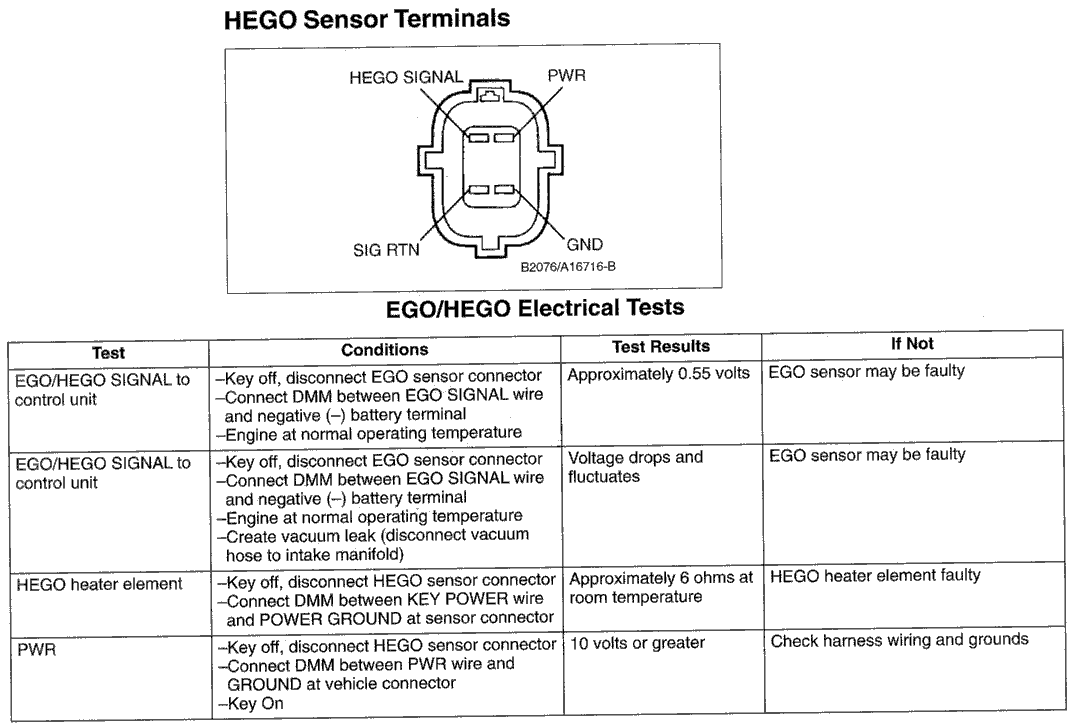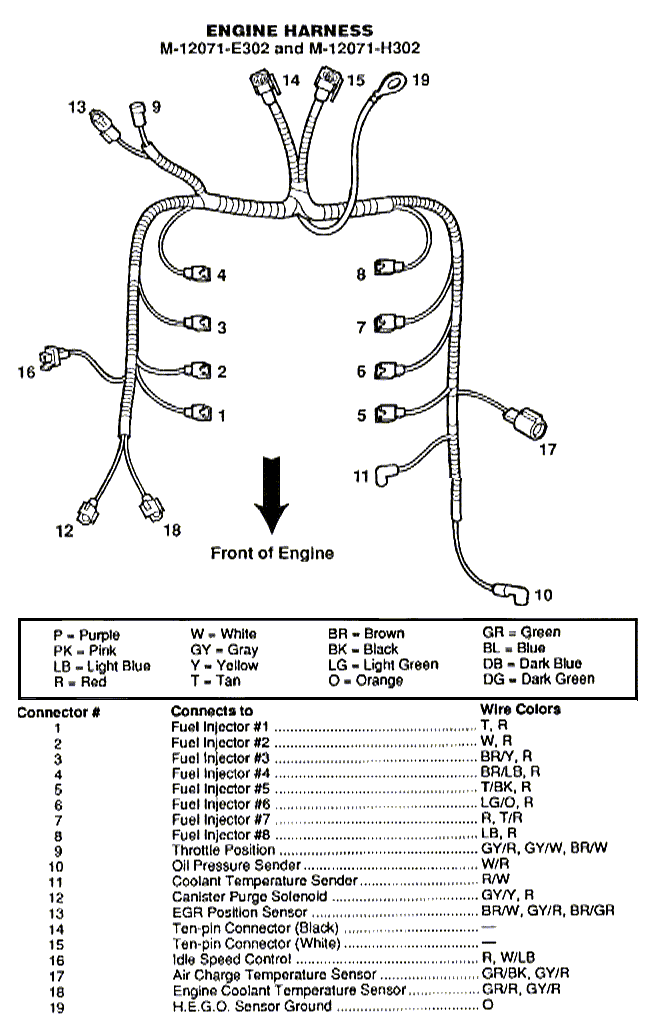This is topic eec-iv koer code 41 in forum Tech Talk at Northern California Ford Owners .
To visit this topic, use this URL:
https://californiafords.com/cgi-bin/ultimatebb.cgi?ubb=get_topic;f=6;t=025281
Posted by sydewayzLX50 (Member # 10217) on
2011-09-18 05:46 PM
:
koeo passed but i keep getting koer code 41 intermittently, what could cause this other than o2 sensors? the check engine light only comes on sometimes and goes away when i restart the car.
Posted by Blind (Member # 3052) on
2011-09-19 10:36 AM
:
Codes Definition:
41 - System Indicates Lean -passenger side(R), No O2 Sensor Switching Detected. always lean -passenger side(CM)
Tools Required: (in addition to the generic tools)
¤ Digital VOM or DMM
¤ Wiring diagrams for your year Mustang
¤ Vacuum diagram for your year Mustang
¤ If a 7/8" open wrench cannot be used to remove O2 sensors, due to the threads being seized, or space limitations, an O2 sensor socket/wrench might be needed.
Testing Procedure:
1. Disconnect the O2S. Measure resistance between the sensor connector terminals PWR and GND (heater). If the reading is 2-30 ohms, the sensor's heating element is okay.
2. With the O2S connected and the engine running at normal operating temperature, measure voltage with DVOM between sensor connector terminals HO2S and SIG RTN. If the voltage reading is 0-1.0V at idle and 0.5-1.0V when accelerating, the sensor is okay.
3. Perform the following tests noting the following, '86-'93 O2 sensors are 3-wire setups, eventhough the following chart shows a 4-wire setup, the tests can be performed as specified. 3-wire sensors DO NOT use a SIG RTN circuit....

Courtesy of TMoss and Veryuseful.com
4. Codes 41/91 (Lean Condition) specific tests:
4a. For codes 41/91 (lean condition), it is always recommended to check the condition of the HEGO GND circuit (pin 49 at ECM connector), a bad/open ground circuit will cause lean readings from the O2 sensors. The HEGO GND is an Orange wire, with a ring connector, that goes bolted to the back of the driver side cylinder head. Identified as item #19 in the following harness diagram.

Courtesy of TMoss and Veryuseful.com
4b. If the HEGO GND connection is OK, do a continuity test from pin 49 at the ECM connector, ECM disconnected, to a good ground source, the resistance reading should be equal/less than 5 ohms....NOK?...trace HEGO GND and repair open condition....OK?...goto 6.
4c. Create an obviously rich condition in the system by doing the following:
Speed Density Systems
* Remove MAP vacuum hose and plug hose.
* With a manual vacuum pump, apply 12"-14" Hg of vacuum to the MAP sensor and verify it holds vacuum, NOK?....replace MAP, repeat KOER self-test, if codes 41/91 show up....continue to next step.
* Start engine and make sure idle is possible with the lowest vacuum applied to the MAP and an obvious rich condition.
* Run a KOER self-test and check if codes 41/91 repeat....they don't?..go to the Mass Air Systems check.....they do?....reconnect MAP sensor vacuum hose, and replace O2 sensors based on the lean code showing.
Mass Air Systems
* Disconnect O2 sensors, probe O2 signal wire of the disconnected O2's with a DVOM to a good ground, run a KOER self-test and monitor O2 signal voltage.
* Repeat test above for both sensors.
* O2 signal should be above .55 vdc at the end of the KOER self-test....NOK?...replace sensor...OK?...perform a continuity check of the O2 signal wires from the O2 harness connectors to the ECM pins....resistance should be less/equal to 5 ohms....NOK?....trace and repair open wire condition and repeat KOER self-test...OK?....next step.
* Disconnect O2 sensors,disconnect ECM, Ign Off, check resistance between O2 signal wires to pins 20, 40, 49 and 60....resistence should be equal/greater than 10,000 ohms....NOK?...trace and repair O2 signal wire short to ground....OK?...replace ECM.
Other Causes for Lean/Rich Codes or Condition
There are other conditions that could cause mixture or O2 related codes, and would need specific checks to be performed. Some are not EEC-IV related, but affects its performance....others affect the logic used to set mixture by modifying the inputs from specific sensors but will not cause a sensor failure code. The specific parameters/components that affect EEC-IV A/F setting are:
¤ Static fuel pressure should not exceed 45psi (Ign On, engine off).
¤ Fuel pressure leakdown should not exceed 5psi in a 60 second period from static reading, if it does, a leaking injector(s), or faulty FPR possibilities should be checked.
¤ Codes 42/92 could be caused by failures in the thermactor system (if "smog stuff" is still operational), a clogged crossover tube or passages at the rear cylinder heads could be the cause for codes 42/92 to be logged during KOER and as CM failures.
¤ Mismatched MAF-injectors condition, a miscalibrated MAF for the injectors installed, could also cause lean or rich conditions. A 36# injectors calibrated MAF could cause a lean condition if 24#/19# injectors are used. A rich condition could happen, if the opposite combo is made, a 19# injectors calibrated MAF, with 24#/36# injectors installed.
¤ Faulty MAP/BP w/out having a failure code 22 logged by the system, to check this possibility go to code 22 Diagnostics in this section.
¤ Clogged PCV valve, hose or intake vacuum source.
¤ The use of an open breather, PCV system has to be a close system style to prevent an unmetered air conditionn, and a lean condition. If breathers are to be installed, the PCV system would have to be removed, and eliminated, to allow the use of open breathers and not have an unmetered air condition.
¤ Engine sealing, vacuum leaks, low compression, valve train problems...are other components that will cause A/F problems and codes.
Posted by sydewayzLX50 (Member # 10217) on
2011-09-19 01:08 PM
:
Thanks for the info, imma bust out the Fluke sometime this week and have at it.
Posted by nineteen90coupe (Member # 8034) on
2011-11-16 09:00 PM
:
.
Posted by rollin5ive0 (Member # 8592) on
2011-11-18 12:38 AM
:
quote:
Originally posted by Blind:
Codes Definition:
41 - System Indicates Lean -passenger side(R), No O2 Sensor Switching Detected. always lean -passenger side(CM)
Tools Required: (in addition to the generic tools)
¤ Digital VOM or DMM
¤ Wiring diagrams for your year Mustang
¤ Vacuum diagram for your year Mustang
¤ If a 7/8" open wrench cannot be used to remove O2 sensors, due to the threads being seized, or space limitations, an O2 sensor socket/wrench might be needed.
Testing Procedure:
1. Disconnect the O2S. Measure resistance between the sensor connector terminals PWR and GND (heater). If the reading is 2-30 ohms, the sensor's heating element is okay.
2. With the O2S connected and the engine running at normal operating temperature, measure voltage with DVOM between sensor connector terminals HO2S and SIG RTN. If the voltage reading is 0-1.0V at idle and 0.5-1.0V when accelerating, the sensor is okay.
3. Perform the following tests noting the following, '86-'93 O2 sensors are 3-wire setups, eventhough the following chart shows a 4-wire setup, the tests can be performed as specified. 3-wire sensors DO NOT use a SIG RTN circuit....

Courtesy of TMoss and Veryuseful.com
4. Codes 41/91 (Lean Condition) specific tests:
4a. For codes 41/91 (lean condition), it is always recommended to check the condition of the HEGO GND circuit (pin 49 at ECM connector), a bad/open ground circuit will cause lean readings from the O2 sensors. The HEGO GND is an Orange wire, with a ring connector, that goes bolted to the back of the driver side cylinder head. Identified as item #19 in the following harness diagram.

Courtesy of TMoss and Veryuseful.com
4b. If the HEGO GND connection is OK, do a continuity test from pin 49 at the ECM connector, ECM disconnected, to a good ground source, the resistance reading should be equal/less than 5 ohms....NOK?...trace HEGO GND and repair open condition....OK?...goto 6.
4c. Create an obviously rich condition in the system by doing the following:
Speed Density Systems
* Remove MAP vacuum hose and plug hose.
* With a manual vacuum pump, apply 12"-14" Hg of vacuum to the MAP sensor and verify it holds vacuum, NOK?....replace MAP, repeat KOER self-test, if codes 41/91 show up....continue to next step.
* Start engine and make sure idle is possible with the lowest vacuum applied to the MAP and an obvious rich condition.
* Run a KOER self-test and check if codes 41/91 repeat....they don't?..go to the Mass Air Systems check.....they do?....reconnect MAP sensor vacuum hose, and replace O2 sensors based on the lean code showing.
Mass Air Systems
* Disconnect O2 sensors, probe O2 signal wire of the disconnected O2's with a DVOM to a good ground, run a KOER self-test and monitor O2 signal voltage.
* Repeat test above for both sensors.
* O2 signal should be above .55 vdc at the end of the KOER self-test....NOK?...replace sensor...OK?...perform a continuity check of the O2 signal wires from the O2 harness connectors to the ECM pins....resistance should be less/equal to 5 ohms....NOK?....trace and repair open wire condition and repeat KOER self-test...OK?....next step.
* Disconnect O2 sensors,disconnect ECM, Ign Off, check resistance between O2 signal wires to pins 20, 40, 49 and 60....resistence should be equal/greater than 10,000 ohms....NOK?...trace and repair O2 signal wire short to ground....OK?...replace ECM.
Other Causes for Lean/Rich Codes or Condition
There are other conditions that could cause mixture or O2 related codes, and would need specific checks to be performed. Some are not EEC-IV related, but affects its performance....others affect the logic used to set mixture by modifying the inputs from specific sensors but will not cause a sensor failure code. The specific parameters/components that affect EEC-IV A/F setting are:
¤ Static fuel pressure should not exceed 45psi (Ign On, engine off).
¤ Fuel pressure leakdown should not exceed 5psi in a 60 second period from static reading, if it does, a leaking injector(s), or faulty FPR possibilities should be checked.
¤ Codes 42/92 could be caused by failures in the thermactor system (if "smog stuff" is still operational), a clogged crossover tube or passages at the rear cylinder heads could be the cause for codes 42/92 to be logged during KOER and as CM failures.
¤ Mismatched MAF-injectors condition, a miscalibrated MAF for the injectors installed, could also cause lean or rich conditions. A 36# injectors calibrated MAF could cause a lean condition if 24#/19# injectors are used. A rich condition could happen, if the opposite combo is made, a 19# injectors calibrated MAF, with 24#/36# injectors installed.
¤ Faulty MAP/BP w/out having a failure code 22 logged by the system, to check this possibility go to code 22 Diagnostics in this section.
¤ Clogged PCV valve, hose or intake vacuum source.
¤ The use of an open breather, PCV system has to be a close system style to prevent an unmetered air conditionn, and a lean condition. If breathers are to be installed, the PCV system would have to be removed, and eliminated, to allow the use of open breathers and not have an unmetered air condition.
¤ Engine sealing, vacuum leaks, low compression, valve train problems...are other components that will cause A/F problems and codes.
now thats a mother fuckin answer, straight up ,legit, and no bullshit lets all follow THIS example ![[worship]](graemlins/worship.gif)
![[worship]](graemlins/worship.gif)
Fueled by Ford Mustang Owners
on CaliforniaFords.com


![[worship]](graemlins/worship.gif)